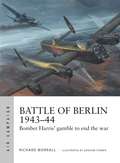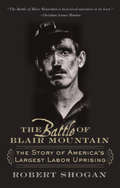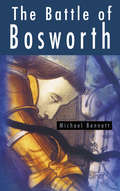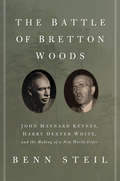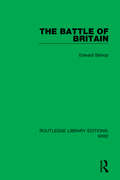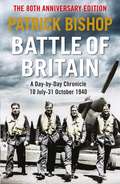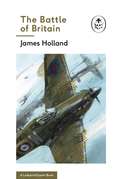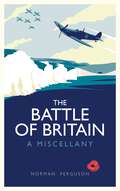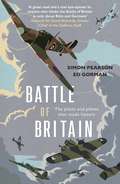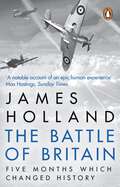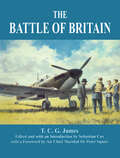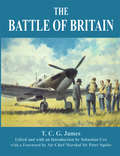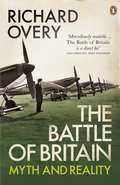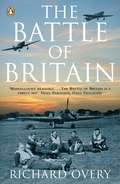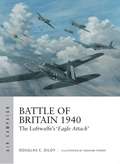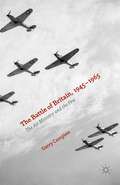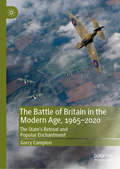- Table View
- List View
Battle of Berlin 1943–44: Bomber Harris' gamble to end the war (Air Campaign)
by Richard WorrallThroughout late-1943 into early-1944, an epic struggle raged over the skies of Germany between RAF Bomber Command and the Luftwaffe. This campaign had been undertaken by the Commander-in-Chief Bomber Command, Air Chief Marshal Sir Arthur Harris, and was baptized 'The Battle of Berlin'. The Berlin campaign was a hard, desperate slog. Struggling against dreadful and bitter winter weather, Bomber Command 'went' to Berlin a total of sixteen times, suffering increasingly severe losses throughout the winter of 1943/44 in the face of a revitalized German air-defence. The campaign remains controversial and the jury, even today, is ultimately undecided as to what it realistically achieved. Illustrated throughout with full-colour artwork depicting the enormous scale of the campaign, this is the story of the RAF's much debated attempt to win the war through bombing alone.
Battle of Berlin 1943–44: Bomber Harris' gamble to end the war (Air Campaign #11)
by Richard WorrallThroughout late-1943 into early-1944, an epic struggle raged over the skies of Germany between RAF Bomber Command and the Luftwaffe. This campaign had been undertaken by the Commander-in-Chief Bomber Command, Air Chief Marshal Sir Arthur Harris, and was baptized 'The Battle of Berlin'. The Berlin campaign was a hard, desperate slog. Struggling against dreadful and bitter winter weather, Bomber Command 'went' to Berlin a total of sixteen times, suffering increasingly severe losses throughout the winter of 1943/44 in the face of a revitalized German air-defence. The campaign remains controversial and the jury, even today, is ultimately undecided as to what it realistically achieved. Illustrated throughout with full-colour artwork depicting the enormous scale of the campaign, this is the story of the RAF's much debated attempt to win the war through bombing alone.
The Battle of Blair Mountain: The Story of America's Largest Labor Uprising
by Robert ShoganIn 1921, some 10,000 West Virginia coal miners-- outraged over years of brutality and exploitation-- picked up their Winchesters and marched against their tormentors, the powerful mine owners who ruled their corrupt state. For ten days the miners fought a pitched battle against an opposing legion of deputies, state police, and makeshift militia. Only the intervention of a Federal expeditionary force ended this undeclared war. In The Battle of Blair Mountain, Robert Shogan shows this long-neglected slice of American history to be a saga of the conflicting political, economic, and cultural forces that shaped the power structure of twentieth-century America.
The Battle of Blair Mountain: The Story Of America's Largest Labor Uprising
by Robert ShoganThe Battle of Blair Mountain covers a profoundly significant but long-neglected slice of American history - the largest armed uprising on American soil since the Civil War. In 1921, some 10,000 West Virginia coal miners, outraged over years of brutality and lawless exploitation, picked up their Winchesters and marched against their tormentors, the powerful mine owners who ruled their corrupt state. For ten days the miners fought a pitched battle against an opposing legion of deputies, state police, and makeshift militia. Only the intervention of a federal expeditionary force, spearheaded by a bomber squadron commanded by General Billy Mitchell, ended this undeclared civil war and forced the miners to throw down their arms. The significance of this episode reaches beyond the annals of labor history. Indeed, it is a saga of the conflicting political, economic and cultural forces that shaped the power structure of 20th century America.
The Battle of Bosworth (Sutton History Paperbacks Ser.)
by Michael BennettOn an August morning more that five hundred years ago, to the sound of thundering hooves, gunshot, the clash of steel and the cries of men in battle, Richard III, King of England, lost his life and the Plantagenet name came to an end. But what do we really know of the battle which became known as Bosworth Field? How do we separate fact from legend when our knowledge is based on sources which by any reckoning are meagre, garbled or partisan? In this classic account Michael Bennett provides as detailed and authoritative a reconstruction of the battle, and the events that led up to it, as is possible. It is an enthralling detective story uncovering the real facts behind one of the most famous of British battles.
The Battle of Bretton Woods: John Maynard Keynes, Harry Dexter White, and the Making of a New World Order
by Benn SteilWhen turmoil strikes world monetary and financial markets, leaders invariably call for 'a new Bretton Woods' to prevent catastrophic economic disorder and defuse political conflict. The name of the remote New Hampshire town where representatives of forty-four nations gathered in July 1944, in the midst of the century's second great war, has become shorthand for enlightened globalization. The actual story surrounding the historic Bretton Woods accords, however, is full of startling drama, intrigue, and rivalry, which are vividly brought to life in Benn Steil's epic account. Upending the conventional wisdom that Bretton Woods was the product of an amiable Anglo-American collaboration, Steil shows that it was in reality part of a much more ambitious geopolitical agenda hatched within President Franklin D. Roosevelt's Treasury and aimed at eliminating Britain as an economic and political rival. At the heart of the drama were the antipodal characters of John Maynard Keynes, the renowned and revolutionary British economist, and Harry Dexter White, the dogged, self-made American technocrat. Bringing to bear new and striking archival evidence, Steil offers the most compelling portrait yet of the complex and controversial figure of White--the architect of the dollar's privileged place in the Bretton Woods monetary system, who also, very privately, admired Soviet economic planning and engaged in clandestine communications with Soviet intelligence officials and agents over many years. A remarkably deft work of storytelling that reveals how the blueprint for the postwar economic order was actually drawn, The Battle of Bretton Woods is destined to become a classic of economic and political history.
The Battle of Bretton Woods: John Maynard Keynes, Harry Dexter White, and the Making of a New World Order
by Benn SteilWhen turmoil strikes world monetary and financial markets, leaders invariably call for 'a new Bretton Woods' to prevent catastrophic economic disorder and defuse political conflict. The name of the remote New Hampshire town where representatives of forty-four nations gathered in July 1944, in the midst of the century's second great war, has become shorthand for enlightened globalization. The actual story surrounding the historic Bretton Woods accords, however, is full of startling drama, intrigue, and rivalry, which are vividly brought to life in Benn Steil's epic account. Upending the conventional wisdom that Bretton Woods was the product of an amiable Anglo-American collaboration, Steil shows that it was in reality part of a much more ambitious geopolitical agenda hatched within President Franklin D. Roosevelt's Treasury and aimed at eliminating Britain as an economic and political rival. At the heart of the drama were the antipodal characters of John Maynard Keynes, the renowned and revolutionary British economist, and Harry Dexter White, the dogged, self-made American technocrat. Bringing to bear new and striking archival evidence, Steil offers the most compelling portrait yet of the complex and controversial figure of White--the architect of the dollar's privileged place in the Bretton Woods monetary system, who also, very privately, admired Soviet economic planning and engaged in clandestine communications with Soviet intelligence officials and agents over many years. A remarkably deft work of storytelling that reveals how the blueprint for the postwar economic order was actually drawn, The Battle of Bretton Woods is destined to become a classic of economic and political history.
The Battle of Britain (Routledge Library Editions: WW2 #1)
by Edward BishopThis book, first published in 1960, is a close examination of the twelve most decisive weeks in British history. It looks at the responsibility of pre-war politicians for the preparedness of the air defence system, the conflicting views on the conduct of the battle on both sides, the attitude of the US, and the part played by such leading figures as Dowding, Park, Beaverbrook, Kesselring and Sperle.
The Battle of Britain (Routledge Library Editions: WW2 #1)
by Edward BishopThis book, first published in 1960, is a close examination of the twelve most decisive weeks in British history. It looks at the responsibility of pre-war politicians for the preparedness of the air defence system, the conflicting views on the conduct of the battle on both sides, the attitude of the US, and the part played by such leading figures as Dowding, Park, Beaverbrook, Kesselring and Sperle.
Battle of Britain: A day-to-day chronicle, 10 July-31 October 1940
by Patrick BishopBattle of Britain is a riveting chronicle of the epic struggle between the Royal Air Force and the Luftwaffe. It is the story of Britain's fight for national survival, from the shock defeat and evacuation from Dunkirk in May/June 1940 to fighter Command's assertion of superiority over the Luftwaffe in mid-September. Battle of Britain takes the reader through that summer day by day, revealing the ongoing battle's impact on flyers and civilians alike. By enhancing his narrative with eye-witness accounts, diary extracts and pilot profiles, Bishop brings the often horrific reality of air combat vividly to life. In Battle of Britain Patrick Bishop has written the definitive account of one of the pivotal moments in twentieth-century British history, and a nation's 'finest hour'.
The Battle of Britain: Five Months That Changed History; May-october 1940 (The Ladybird Expert Series)
by Keith Burns James HollandPart of the new Ladybird Expert series, Battle of Britain is an accessible, insightful and authoritative account of the most famous aerial battle in history.Historian, author and broadcaster James Holland draws on the latest research and interviews with participants to bring colour, detail and a fresh perspective to the story.Inside, you'll discover how tactics, organisation and new technologies were brought to bear, about the different challenges faced by both the RAF and the Luftwaffe, and, above all, the skill, bravery and endurance of the airmen engaged in a contest that was of critical importance to the outcome of the war. Written by the leading lights and most outstanding communicators in their fields, the Ladybird Expert books provide clear, accessible and authoritative introductions to subjects drawn from science, history and culture.Other books currently available in the Ladybird Expert series include:· Climate Change· Quantum Mechanics· Evolution· ShackletonFor an adult readership, the Ladybird Expert series is produced in the same iconic small hardback format pioneered by the original Ladybirds. Each beautifully illustrated book features the first new illustrations produced in the original Ladybird style for nearly forty years.
The Battle of Britain
by Nigel Cawthorne"Never in the field of human conflict was so much owed by so many to so few" - Churchill on the RAF.The fate of Britain was balanced on a knife edge after Hitler ordered the Luftwaffe to destroy the RAF. German aircraft outnumbered Britain's forces four to one, and the Luftwaffe was inexorably gaining the upper hand. It was touch and go whether the nation could survive.This landscape-format book presents an incredible pictorial history of the Battle of Britain. Over 200 full-page photographs reveal the twists and turns of this momentous air battle and the men and women who fought for their nation. Images feature:• The courageous 'Few' who fought from the skies, including Douglas Bader and Johnnie Johnson.• Local defence volunteers who prepared on the ground• The various aircraft that defined this battle, featuring the iconic Spitfire, the Hurricane and the German Messerschmitt Bf 109.• Scenes of tragedy and jubilation, including the London Blitz and final VE day celebrations in Trafalgar square. These spectacular photographs are accompanied by fascinating captions and chapter text which narrates the action. Emphasising the human side to this battle, The Battle of Britain is a moving tribute to a men and women who pulled together in the face of overwhelming odds and pushed back against Adolf Hitler.
The Battle of Britain: A Miscellany
by Norman FergusonHave you ever wondered...• How fast a Spitfire could travel?• Which pilot won Fighter Command’s only Victoria Cross?• What a ‘Stuka Party’ was?Telling the stories of the commanders, the air raids, the pilots, the aircraft and the vital use of the world’s first radar air defence system, this comprehensive miscellany is a compelling guide to this most crucial of Second World War battles – the first to be fought solely in the air.
Battle of Britain: The pilots and planes that made history
by Ed Gorman Simon PearsonIn Battle of Britain: The Pilots and the Planes That Made History, Ed Gorman and Simon Pearson paint a vivid picture of the men and their machines as the battle for air superiority over Britain is played out across the skies of Europe, from western Ireland to the German capital.They tell remarkable stories involving hitherto unknown airmen from across the world who flew aircraft, including some that will be new to many readers: the New Zealander who "borrowed" a seaplane from the Royal Navy to set up a freelance air-sea rescue service that saved the lives of dozens of British and German pilots; the Swiss baron who destroyed nine British fighters in a day; the vainglorious Dane whose RAF squadron was wiped out trying to disrupt Nazi invasion plans; and the German bomber pilot who fought the last battle involving foreign troops on British soil since Culloden - before repairing to a pub in Kent for a pint with soldiers from the Irish Rifle, who had taken him prisoner.Illustrated with contemporary photographs of the pilots and their aircraft, these are enthralling stories from both sides of a conflict that shaped the modern world, full of courage, endeavour and above all, humanity.
The Battle of Britain: The Unique True Story Of Five Months Which Changed The War May - October 1940 (The\ladybird Expert Ser. #7)
by James Holland'Hitler knows that he will have to break us in this island or lose the war.' (Sir Winston Churchill, speech to the House of Commons, 18 June 1940)The Nazi Blitzkrieg was unlike any invasion the world had ever seen. It hit Europe with a force and aggression that no-one could counter. Within weeks the German armies were at the French coast and looking across at Britain, a country still reeling from the opening salvoes of the war. It seemed impossible that she would be able to resist invasion. But between the Nazis and glory stood more than just the pilots of Fighter Command. There was Bomber and Coastal Command, the Royal Navy and the incredible Auxiliary Patrol Service. In this darkest hour, Britain's defence was truly a national effort, and one that had been considerably better prepared for than the German attack.For the first time, The Battle of Britain tells this most epic of stories from a 360° perspective, drawing on extensive new research from around the world that challenges some of the long-held myths about the battle. Holland paints a complete picture of that extraordinary summer - a time in which the fate of the world truly hung by a thread.
The Battle of Britain: Air Defence of Great Britain, Volume II (Royal Air Force Official Histories #Vol. 2)
by T.C.G. JamesThis is the second volume of the classified history of air defence in Great Britain. Written while World War II was still being fought, the account has an analysis of the defensive tactics of Fighter Command, and attempts a day-by-day analysis of the action as it took place.
The Battle of Britain: Air Defence of Great Britain, Volume II (Royal Air Force Official Histories)
by T.C.G. JamesThis is the second volume of the classified history of air defence in Great Britain. Written while World War II was still being fought, the account has an analysis of the defensive tactics of Fighter Command, and attempts a day-by-day analysis of the action as it took place.
The Battle of Britain (General Aviation Ser.)
by Kate Moore The Imperial The Imperial War MuseumIn 1940 Britain was an island under siege. The march of the Nazi war machine had been unrelenting: France and Belgium had quickly fallen and now the British Empire and the Commonwealth stood alone to counter the grave threat. However, their fate would not be decided by armies of millions but by a small band of fighter pilots. It was on their shoulders that Britain's best chance of survival rested. Above the villages and cities, playing fields and market towns, the skies of southern England were the scene of countless dogfights as the fledgling Fighter Command duelled daily against the might of the Luftwaffe. The Battle of Britain offers an in-depth assessment of the situation leading up to the summer of 1940, the strategies employed by the adversaries and the brutal aerial battle itself. Lavishly illustrated with photographs, contemporary art and posters, and accompanied by numerous first-hand accounts, this is a volume that captures the reality of a defining chapter in British history.
The Battle of Britain
by Kate Moore The Imperial The Imperial War MuseumIn 1940 Britain was an island under siege. The march of the Nazi war machine had been unrelenting: France and Belgium had quickly fallen and now the British Empire and the Commonwealth stood alone to counter the grave threat. However, their fate would not be decided by armies of millions but by a small band of fighter pilots. It was on their shoulders that Britain's best chance of survival rested. Above the villages and cities, playing fields and market towns, the skies of southern England were the scene of countless dogfights as the fledgling Fighter Command duelled daily against the might of the Luftwaffe. The Battle of Britain offers an in-depth assessment of the situation leading up to the summer of 1940, the strategies employed by the adversaries and the brutal aerial battle itself. Lavishly illustrated with photographs, contemporary art and posters, and accompanied by numerous first-hand accounts, this is a volume that captures the reality of a defining chapter in British history.
The Battle of Britain: Myth and Reality
by Richard OveryThe Battle of Britain tells the extraordinary story of one of the pivotal events of the Second World War - the struggle between British and German air forces in the late summer and autumn of 1940. Exposing many of the myths surrounding the conflict, the book provides answers to important questions: how close did Britain really come to invasion? What were Hitler and Churchill's motives? And what was the battle's real effect on the outcome of the war? Told with great clarity and objectivity, this is a superb introduction to a defining moment in our history.'No individual British victory after Trafalgar was more decisive in challenging the course of a major war than was the Battle of Britain ... In his carefully argued, clearly explained and impressively documented book ... Richard Overy is at pains to dispose of the myths and expose the real history of what he does not doubt was a great British victory ... the best historical analysis in readable form which has yet appeared on this prime subject' Noble Frankland, The Times Literary Supplement
The Battle of Britain: New Edition
by Richard Overy'No individual British victory after Trafalgar was more decisive in challenging the course of a major war than was the Battle of Britain ... In his carefully argued, clearly explained and impressively documented book ... Richard Overy is at pains to dispose of the myths and expose the real history of what he does not doubt was a great British victory ... the best historical analysis in readable form which has yet appeared on this prime subject' Noble Frankland, The Times Literary Supplement
Battle of Britain 1940: The Luftwaffe’s ‘Eagle Attack’ (Air Campaign #1)
by Graham Turner Doug DildyIn August 1940, the Luftwaffe began an operation to destroy or neutralize RAF Fighter Command, and enable Hitler to invade Britain that autumn. It was a new type of air warfare: the first ever offensive counter-air campaign against an integrated air defence system. Powerful, combat-proven and previously all-conquering, the German air force had the means to win the Battle of Britain. Yet it did not.This book is an original, rigorous campaign study of the Luftwaffe's Operation Adlerangriff, researched in Germany's World War II archives and using the most accurate data available. Doug Dildy explains the capabilities of both sides, sets the campaign in context, and argues persuasively that it was the Luftwaffe's own mistakes and failures that led to its defeat, and kept alive the Allies' chance to ultimately defeat Nazi Germany.
Battle of Britain 1940: The Luftwaffe’s ‘Eagle Attack’ (Air Campaign #1)
by Graham Turner Doug DildyIn August 1940, the Luftwaffe began an operation to destroy or neutralize RAF Fighter Command, and enable Hitler to invade Britain that autumn. It was a new type of air warfare: the first ever offensive counter-air campaign against an integrated air defence system. Powerful, combat-proven and previously all-conquering, the German air force had the means to win the Battle of Britain. Yet it did not.This book is an original, rigorous campaign study of the Luftwaffe's Operation Adlerangriff, researched in Germany's World War II archives and using the most accurate data available. Doug Dildy explains the capabilities of both sides, sets the campaign in context, and argues persuasively that it was the Luftwaffe's own mistakes and failures that led to its defeat, and kept alive the Allies' chance to ultimately defeat Nazi Germany.
The Battle of Britain, 1945-1965: The Air Ministry and the Few
by Garry CampionSeventy-five years after the Battle of Britain, the Few's role in preventing invasion continues to enjoy a revered place in popular memory. The Air Ministry were central to the Battle's valorisation. This book explores both this, and also the now forgotten 1940 Battle of the Barges mounted by RAF bombers.
The Battle of Britain in the Modern Age, 1965–2020: The State’s Retreat and Popular Enchantment
by Garry CampionThe Battle of Britain has held an enchanted place in British popular history and memory throughout the modern era. Its transition from history to heritage since 1965 confirms that the 1940 narrative shaped by the State has been sustained by historians, the media, popular culture, and through non-governmental heritage sites, often with financing from the National Lottery Heritage Lottery Fund. Garry Campion evaluates the Battle’s revered place in British society and its influence on national identity, considering its historiography and revisionism; the postwar lives of the Few, their leaders and memorialization; its depictions on screen and in commercial products; the RAF Museum’s Battle of Britain Hall; third-sector heritage attractions; and finally, fighter airfields, including RAF Hawkinge as a case study. A follow-up to Campion’s The Battle of Britain, 1945–1965 (Palgrave, 2015), this book offers an engaging, accessible study of the Battle’s afterlives in scholarship, memorialization, and popular culture.
